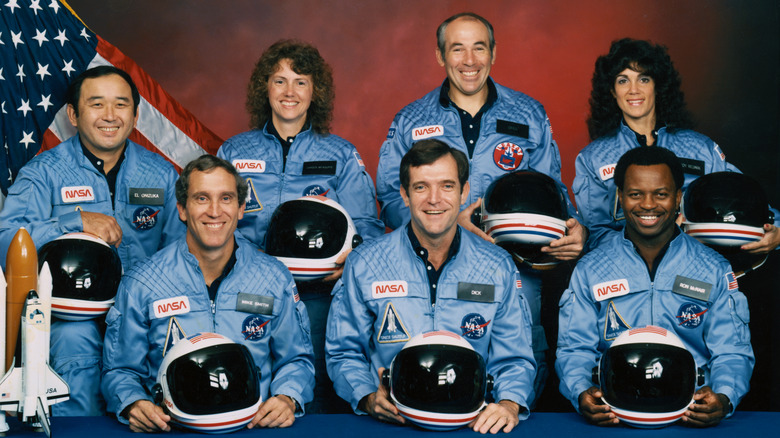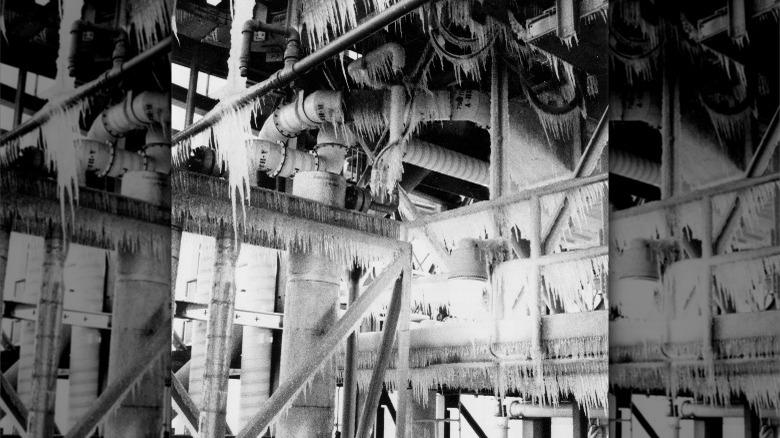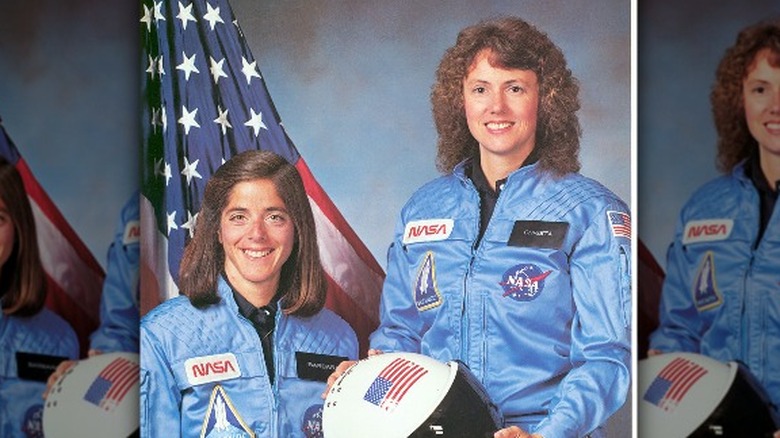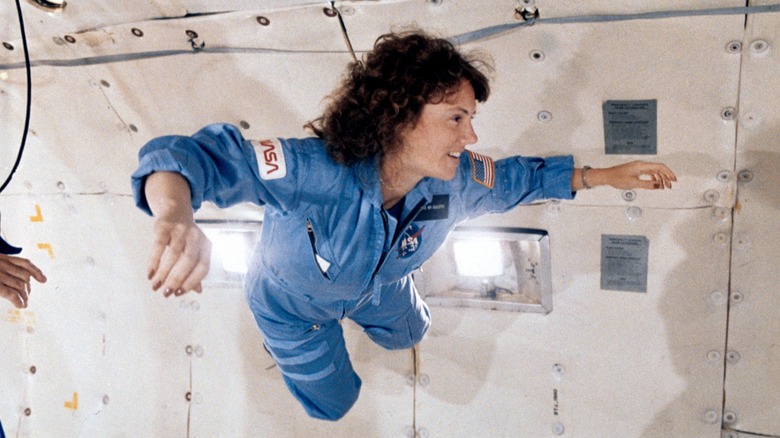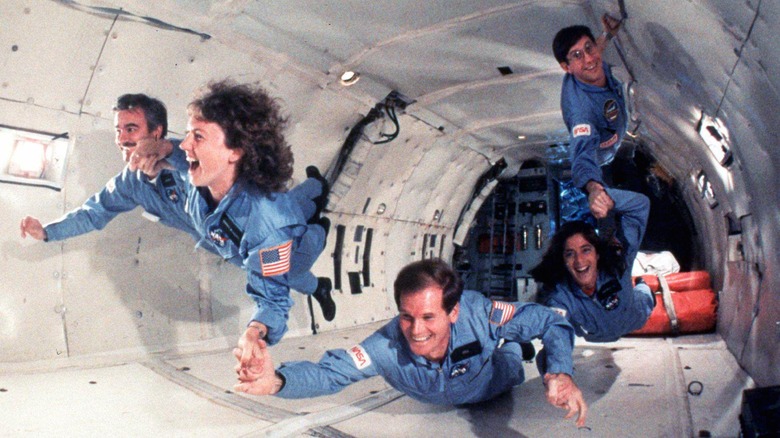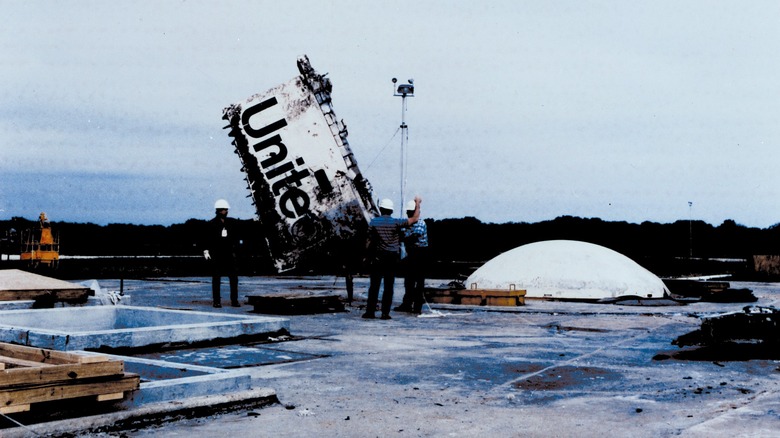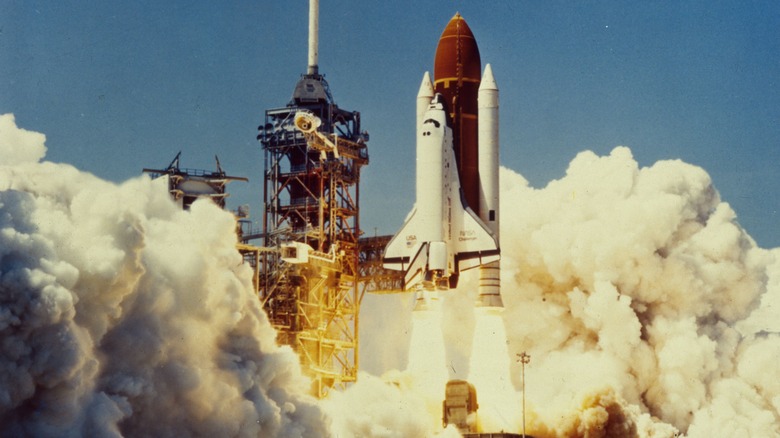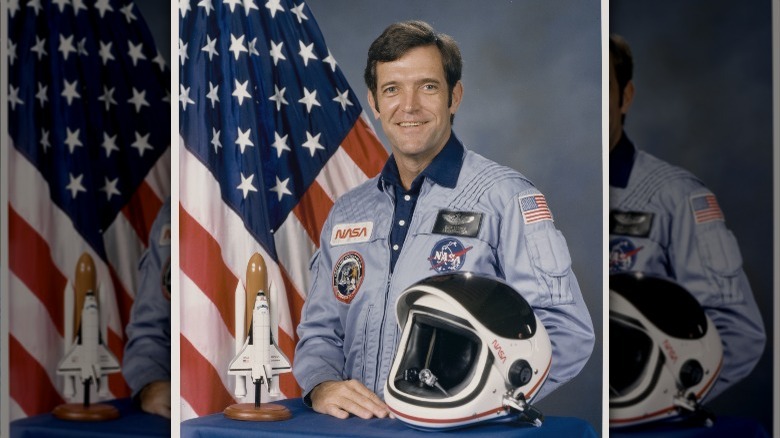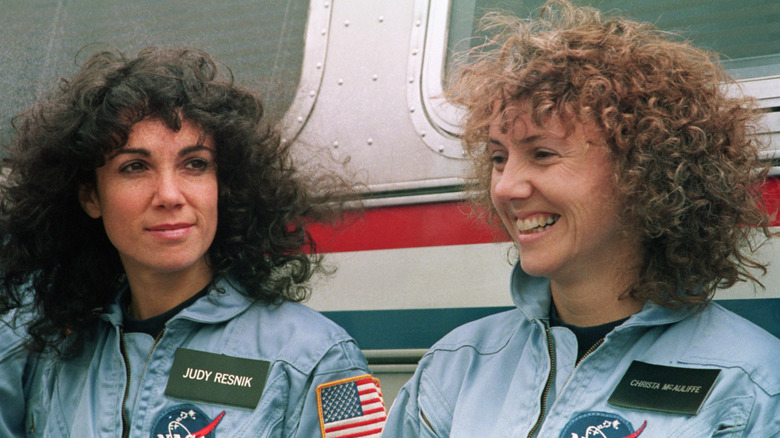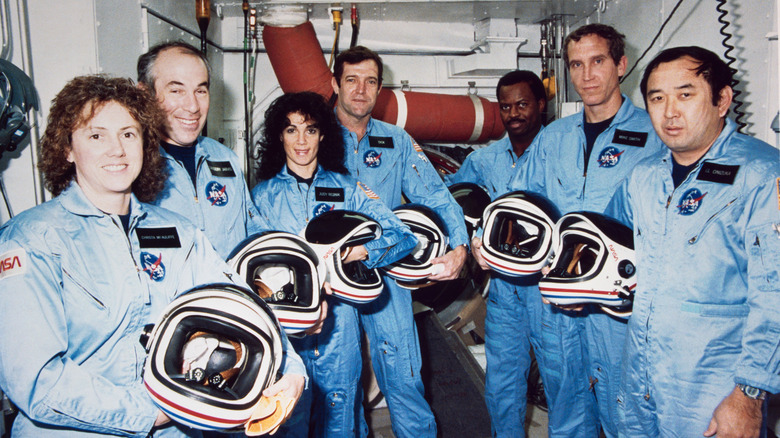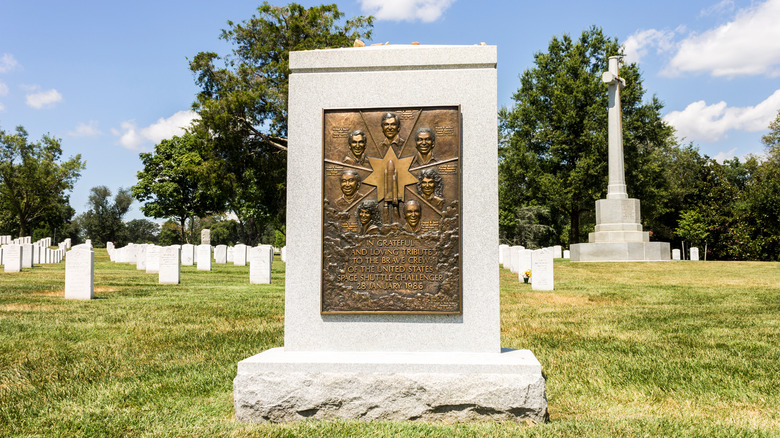The Hidden Truth Of The Space Shuttle Challenger Crew
Space travel no longer seems like some far-off fantasy. Sure, it's still a wildly expensive endeavor, but maybe it won't be too long before the everyday person can also see what it's like to sail through the stars. It's a pretty wondrous concept, but it's worth remembering that all the technological advancements that got us to this point came at a price.
Perhaps the more infamous of those costs are the lives of the astronauts aboard the Challenger space shuttle. If you're not familiar with the Challenger disaster, here's your primer: On January 28, 1986, the Challenger was meant to take off from Cape Canaveral, Florida. On board were seven astronauts — Francis "Dick" Scobee, Michael Smith, Ellison Onizuka, Judith Resnik, Ronald McNair, Christa McAuliffe, and Gregory Jarvis. The crew's main mission was simply to launch a couple of satellites, but just over a minute after lifting off into the cold air, the craft exploded in a giant fireball. Bits of the shuttle rained into the ocean, but the bodies of the crew were never recovered, sending shockwaves across the nation as missions were effectively grounded, and kickstarting investigations that would leave NASA never the same again.
The seven crew members meant a lot of things to a lot of people, and here are some lesser-known details about them.
The crew didn't have to die
Technically speaking, the Challenger space shuttle didn't exactly explode. Its launch date of January 28 was a really cold day, and the weather caused the rubber O-rings in the booster rockets not to seal properly. When the engines started, the flames and hot gas were able to leak out and start damaging equipment, eventually causing a fireball as the shuttle fell apart.
It was a tragedy, but an avoidable one. The engineers at Morton Thiokol — the contractor working with NASA — knew that this would be an exceptionally cold launch day, and they also knew that there was a really good chance that those O-rings wouldn't seal the way they were supposed to as a result of those temperatures. They brought the problem to their superiors, who then took the issue to NASA, asking them to delay the launch. Unfortunately, the officials at NASA had very different priorities. Granted, those exact priorities have never been fully identified. One possibility? One of the engineers said, "They [NASA] had their mind set on going up and proving to the world they were right and they knew what they were doing. But they didn't" (via NPR). It was also possible that government officials wanted the launch to line up with President Ronald Reagan's State of the Union address.
Either way, though, those pressures ultimately meant that Thiokol supervisors decided to make the executive decision to allow the launch. Meanwhile, the engineers knew that they were sending the astronauts to their deaths.
Christa McAuliffe meant a lot to the teaching profession
One of the really big bits of trivia about the crew of the Challenger has to do with Christa McAuliffe; namely, it's the fact that McAuliffe herself wasn't a trained astronaut in quite the same way as the rest of the crew. The other six astronauts came from the backgrounds you would expect — aviation, military, or scientific. McAuliffe, however, was a normal teacher, and she was actually chosen by NASA (one applicant out of over 11,000, in fact) as part of a special program to put an educator in space. Both she and the Challenger mission got quite a bit of press as a result.
But according to Barbara Morgan — McAuliffe's alternate for the Challenger mission — in an interview with Space, this was way more than just an interesting gimmick. The teaching profession was actually in a pretty bad place in the mid-1980s, with educators often looked down upon or disrespected. But McAuliffe's inclusion on the Challenger crew really helped to mitigate that, as she proved to be an effective ambassador for all teachers. All of a sudden, more students were looking up to their teachers — many even wanted to become teachers themselves, or, if nothing else, Morgan explained that McAuliffe inspired them to take risks and believe they could do anything.
What's more, according to Morgan, that effect — inspiring and helping the next generation — seems to be exactly what McAuliffe hoped to achieve. After all, her saying was apparently, "I touch the future, I teach."
Some students were affected especially deeply by the disaster
Given that Christa McAuliffe was a teacher, it's not really much of a surprise to know that on the day of the Challenger launch, plenty of schools organized watch parties for the big moment — which ultimately meant that they bore witness to the disaster in real time.
Understandably, students reacted with varying levels of shock, with some explaining that it took them a while to fully understand what was even happening. Others mentioned that they had to wrap their head around the reality of it all; seeing an explosion in a movie was one thing, but watching it happen in real life was another.
But the most visceral reactions came from McAuliffe's own students. After all, the kids knew her as their beloved history teacher, and they'd all gathered in the school's cafeteria to watch, dressed in party gear as they cheered. For a while, they didn't even know that anything had gone wrong, believing the explosion was just the rocket firing, until another teacher yelled for them to shut up. After which the room descended into eerie silence, and the truth began settling in. Despite hopes that the accident wasn't fatal, there was no denying what happened, and McAuliffe's students could only reflect and remember. Whether that be the realization by one student that "She didn't get to teach those lessons she really wanted to teach us," or the memory of how "She just made us feel ... that we were part of it with her" (via Today).
The crew was likely in good spirits right until the end
The image of the Challenger space shuttle going up in flames and disintegrating high in the sky is a harrowing one, and that almost makes it easy to imagine that the entire thing was a scary affair from start to finish. But that might not have actually been true.
In the aftermath of the disaster, there was plenty of debris and associated information that couldn't be retrieved, but one of the things that was recovered was the audio transcript of the crew in the minutes leading up to — and during — the launch. And the little bits of conversation caught between the crew seem to paint a picture of a bunch of people who were just looking forward to their mission. Just under two minutes before the launch, there was plenty of laughter among the crew, with Ellison Onizuka apparently making some jokes that Michael Smith just responded to with, "God I hope not Ellison."
And the good mood just carried on through even after the shuttle left the ground. Moments of cheering could be heard through shouts like "Ooohh-kaaay" and "Feel that mother go ... Woooohoooo." Then, of course, there was also just a little bit of swearing as Judith Resnik declared that the launch was "hot."
The crew might have been conscious through some of the disaster
The audio transcript of the crew during the Challenger launch depicts seven people enjoying each other's company. At least, that was true up until the 73-second mark, when the feed suddenly cut out and all communication with Challenger was lost. But not without one last, haunting word: pilot Michael Smith simply saying, "Uh oh."
Those couple of words made people start to wonder what had actually happened inside the shuttle during those last moments. Did the astronauts know what had happened? Or had they immediately perished? Well, further investigation seemed to indicate that the crew might have had a few seconds of consciousness — potentially up to 15 seconds — during which they definitely knew what was happening. Not only was there Smith's exclamation, but upon recovering some of the debris, it appeared that some of the air packs had been turned on and a majority of their air depleted. As far as anyone could tell, it seemed like at least a few of the crew members were conscious enough to see something going wrong — though what they experienced is still a mystery.
Still, that wouldn't have been enough for them to survive. Reports said that the later loss of pressure could have caused them to lose consciousness, and it's most likely that they wouldn't have had enough time to wake back up before the remains of the cabin fell into the sea.
No one knows what the Challenger crew experienced in their last moments
As you'd probably expect, in the aftermath of the Challenger disaster, there were a bunch of investigations launched as experts tried to determine exactly what had happened to the crew after the explosion. Despite all that work, though, according to NASA's official report, there weren't many conclusions to be had. Mostly just questions, really.
While the cabin fell into the ocean, given the height it fell from it impacted with about 200 G's of force — more than enough to kill all seven astronauts, but also enough to cause massive structural damage to the cabin itself. The report ruled: "The impact ... was so violent that evidence of damage occurring in the seconds which followed the explosion was masked."
In practice, that also meant that no one had any idea what the true cause of death was for the crew. They might have been injured by the forces exerted by the shuttle falling apart, but there's no way of telling if they did, or to what extent. They might have lost consciousness as the cabin fell apart — which seems likely, as their seats still seemed to be occupied when they hit the water — but again, there's no real way to prove anything. That hypothetical loss of pressure might have caused some damage to the cabin, or some of the damage might have been caused by flying debris. And those are just a couple of the unanswered questions.
Dick Scobee's personal belongings were both tragically haunting and inspiring
The Challenger disaster sent waves of grief across the nation, and for perfectly understandable reasons; it was a national tragedy, after all. But it's also worth remembering that all of the crew members had their own lives, their own people who loved them. And there's a story regarding the family of Francis "Dick" Scobee that serves as a reminder of that fact.
The families of many of the astronauts were personally at the launch, and after seeing the disaster unfold in front of them, they were all ushered back to the crew quarters. With nothing to do but wait for bad news, Scobee's wife and kids happened upon his briefcase, left behind in his room. And in the briefcase? The usual things you'd expect: wallet, keys, business cards, photos of his family, and information related to his job. But there was more — perhaps most notably, a Valentine's Day card for his wife, still unsigned, and another thing that's perhaps more inspiring: a page bearing a quote by Ben Bova.
As the quote goes, "We have whole planets to explore. We have new worlds to build. We have a solar system to roam in. And if only a tiny fraction of the human race reaches out toward space, the work they do there will totally change the lives of all the billions of humans who remain on Earth." Just a few sentences that truly encapsulate the goals of the Challenger crew, as well as those that their families still pursue.
McAuliffe wasn't a big hit with everyone
The inclusion of Christa McAuliffe on the crew of the Challenger was a move that went over really well with the media and the public — that's not exactly something new, given the attention the launch got in schools across the nation. But for all that McAuliffe was a hit when it came to PR, the same couldn't exactly be said when it came to the rest of the crew.
See, the existence of the "Teacher in Space" program came about due to some questionable things about Ronald Reagan's presidency, which had alienated teachers around the same time. This was ultimately a way to try and win back popular support, while also showing off space exploration even more publicly. Given that McAuliffe's seat only existed for PR reasons, the rest of the crew wasn't exactly fond of her at first. After all, they had friends who'd been training and studying for years, working on their qualifications, only to be denied so that a teacher could go to space.
Not a great start, for sure. But things didn't stay frosty forever. On one hand, the rest of the crew couldn't exactly ignore the fact that McAuliffe's presence was bringing loads of attention to the space program — a definite boon — and even those who loathed the way in which the capriciously secretive NASA was pandering to the media, like Judith Resnik, grew to respect her and her work ethic.
The Challenger crew was one of the most diverse crews to date
When you look at the crew of the Challenger, most of the focus is directed toward Christa McAuliffe, and for understandable reason, given she was the first civilian slated to go to space. But if you peel things back a bit further and take a look at the rest of the crew, you'd find that, on the whole, they represented a pretty wide variety of different communities in America — perhaps another reason why the tragedy was felt among so many different people.
Just going down the list, Ellison Onizuka was the first Asian American to ever go into space as a part of the Discovery crew in 1985. That flight cemented his hero status in his home state of Hawaii, as well as in Asian American communities more generally. Ronald McNair was only the second Black person to ever go to space, coming from a low-income home in a segregated city. Judith Resnik was a brilliant engineer who joined NASA at the age of 28, and she would become both the second woman and first Jewish American to go to space. What's more, with both McAuliffe and Resnik on board, this was only the second time that a single mission had two women on its crew.
The final fates of the Challenger crew
When the Challenger broke apart, it left the crew cabin tumbling nearly nine miles, in free fall, towards the ocean. All of that force was enough to completely shatter the cabin on impact, leaving the debris – little more than barely recognizable rubble – to sink down to the bottom of the ocean. Recovery efforts took a couple of months, and during that time, there was very little word given to the public about exactly what was happening, especially where the bodies of the astronauts were involved. Only at the end of that time — the point at which it seemed NASA was confident they'd finally found all the bodies of the Challenger crew — was there any announcement.
It was rather gruesome news, however. Considering the impact was enough to shatter a spacecraft, well, grim as it is to think about, it's probably unsurprising that the bodies were reportedly unrecognizable. Not just indistinct from each other, but difficult to recognize as human remains at all.
Ultimately, most of the remains were individually identified, and in a solemn ceremony, many of them were returned back to their homes and families for burial, while Smith and Scobee's remains were transferred to Arlington National Cemetery. Not all of the remains could be identified, however, and those were given a separate ceremony: cremated and buried in Section 46 of Arlington, where there now stands a memorial to all seven astronauts of the Challenger crew.
